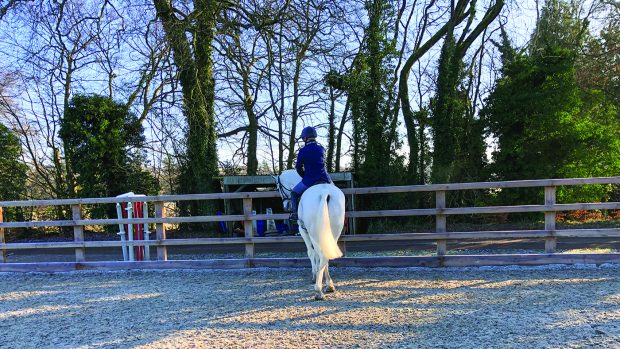Have you ever watched the haute école horses at the Spanish Riding School of Vienna, or France’s Cadre Noir, and been awestruck at the smooth, balletic movements? Those stunning ‘airs above the ground’ high school movements such as capriole and levade require a very high level of skill and training, but are always taught from the ground first rather than the saddle. Many trainers now use the same principles to teach dressage movements including half pass, piaffe, and shoulder-in from the ground.
In Europe, in-hand training is common at all levels, and it’s gaining momentum in the UK as well. Carl Hester and Charlotte Dujardin have recently been publicising the discipline with Florian Bacher of the Spanish Riding School, who’s been helping to improve their horses’ performance with in-hand work.

Charlotte Bailey and her Lipizzaner Tuli
“It’s an extremely accessible and useful discipline, as to start with you only need a well-fitting cavesson or bridle and a schooling whip, and it benefits any and every horse from a Shetland to a Shire,” says Charlotte Bailey, a Cheshire-based trainer who’s been specialising in in-hand work for many years. “It’s not the same as lungeing or long-reining, it’s really more ‘riding from the ground’. It’s a great way of teaching the ridden aids to an unbacked young horse before you get on, and it’s all about encouraging forward movement, correct balance and posture right from the beginning.”
Swedish classically-trained dressage rider, trainer and teacher Charlotte Wittbom (pictured top in white) has been riding all her life, and spent four years working as an instructor at the acclaimed Morgado Lusitano riding centre in Portugal, which specialises in classical approaches to horsemanship.
“I have been working horses from the ground since I first got the opportunity to learn about 15 years ago when I was in Portugal,” she says. “I do all the lateral exercises from the ground, starting with bringing the horse’s hindquarters around his shoulders then shoulders around his hindquarters, which leads on to leg yield, shoulder-in and shoulder-out, travers, half-pass, renvers and pirouettes. When the horse can perform these movements with ease, we build up to the more collected exercises such as piaffe and — if there is a wish and purpose for it — the airs above the ground.

Charlotte Bailey and her Lipizzaner Tuli
“In-hand work helps us see how the horse carries himself and work out exactly where he needs more help to strengthen. It can allow a more objective and clearer view of how he moves and responds to aids, without the influence of your weight and physical idiosyncrasies on his back. By allowing him this grounding — and allowing yourself a greater understanding of the mechanics of your partnership — you will be better empowered to achieve harmony in your riding.”
“Although it might look easy, the handler’s own body language and posture is vital,” says Charlotte Bailey. “If you get in front of the horse you can block their movement, if you’re behind then they can start to drag you. You have to be really disciplined with your own posture. If you look at videos on YouTube you’ll see handlers achieving some really impressive results, but do remember that they’ve been training those horses a long time. If you’re interested, do go to a clinic or find an instructor who specialises in this type of work so that they can show you the basics as it’s easy to get it wrong.

Charlotte Bailey and her Lipizzaner Tuli
“I love in-hand work, as I love developing a bond with the horses and watching them have a ‘light bulb’ moment when they figure out what you mean! It’s very rewarding, and you can just do 15 minutes here and there to suit you — even round the yard if you don’t have an arena. It keeps older horses extremely flexible, as well — the Spanish Riding School horses sometimes stay in work until their late 20s.
“Any horse from any discipline can benefit from ground work, just like yoga will benefit any athlete or sportsperson with a foundation of flexibility, core strength and poise.
Article continues below…
You might also be interested in:

Fancy trying your hand at horse agility? Here’s what you need to know first…

Try something new in 2019 — polo
Would you like to have a taster of a new equestrian discipline this year? Sara Walker talks us through how

Subscribe to Horse & Hound magazine today – and enjoy unlimited website access all year round
“I’d encourage anyone to try with their own horse,” says Charlotte Wittbom. “It’s nice to work your horse in different ways — it improves the relationship. Like any discipline, the more you practice the better you’ll get and mistakes are inevitable at the beginning. Be patient with yourself and your horse so that you have time to enjoy your journey together.
Many classically-trained instructors now offer in hand lessons or clinics – look at local equestrian websites or search Facebook for events near you.
For all the latest equestrian news and reports, don’t miss Horse & Hound magazine, out every Thursday.




